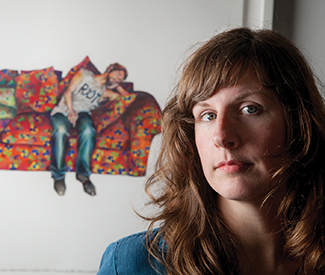marke@sfbg.com
GOLDIES The San Francisco Art Institute’s landmark 2012 MFA exhibition sprawled through the kitschy Phoenix Hotel in the Tenderloin, partnering artists with often radically different styles in each room. Seen from one angle, it hilariously replicated one particular nostalgia-inducing area of the Internet: bright and noisy chatrooms, overflowing with random strangers, streaming with argument, affinity, and information overload.
Standout exhibitor Michelle Ramin used the opportunity to kick that proto-social media vibe up a notch: “I took one look at the closet and thought, ‘This could be a photobooth,'” she told me over drinks at the Dogpatch Saloon. “That was when every party had to have a photobooth and Instagram was getting popular. There were also a lot of issues of surveillance in the news. I wired the photobooth to the TV permanently installed in the room and displayed the resulting photographs in real time to onlookers.”
But there was one more essential element. Working with programmer Jesse MacDonald, Ramin developed a “Mask Booth” Android app that superimposed her trademark motif — a ski mask — over everyone’s face. That balaclava (menacing, deracinating, liberating, everywhere in pop culture right now, from Pussy Riot to Spring Breakers) shows up often in Ramin’s gorgeous figurative colored pencil drawings and oil paintings, which popped off the Phoenix’s walls.
The masks are donned by “privileged hip young people at leisure” and come in stark contrast to their surroundings. In Three Aliases (2011), a bemasked trio of American Apparel-ready loungers puppy-piles onto a dazzling floral sofa; a scruffy male in a pixilated shirt pushes another masked figure forward on a tricycle with almost violent glee in Joel and Jewel.
“I’m fascinated by how we mask ourselves to form our online profiles, how we develop, or overdevelop, another identity that’s really only just a part of ourselves, but that we find acceptable to share with the world. But there’s another part of ourselves that we call ‘private’ that we also hide behind a mask.” Ramin told me. “We create these dual identities, and there’s a danger of one or the other going off balance.”
“But the mask is also liberating” — Oscar Wilde’s old saw “Give a man a mask and he will tell you the truth” — “and it has its own history of transformation. It started out as something to protect against the cold, but now its come to mean many other things, from terrorism to fashion statement.”

Guardian photo by Saul Bromberger and Sandra Hoover
Ramin was born in 1982 and knew from a young age that she wanted to be an artist. After earning a Fine Arts B.A. at Penn State, she and her now-husband, who appears in many of her works, followed their art dreams to New York City. But they found the experience isolating and expensive, so they impulsively loaded up their car and moved to Portland. “We suddenly found a community, and a close circle of friends. We could work part-time and survive, have a life.” Ramin’s art from that period, of bridges and colorful landscapes, reflected that new-found connectivity and sense of home.
Her move to Portland coincided with the rise of Etsy and the explosion of the online handmade craft marketplace, and her artworks were perfect for the medium. “I could be my own dealer, I was successful, and I suddenly had a platform that reached the whole world,” she said. But she wanted to continue developing, and started looking toward a master’s degree at SFAI, drawn to work with associate professor Brett Reichman, who would become her mentor. She funded her move to SF through an ingenious art auction that linked Etsy to eBay, and anticipated the crowdfunding craze.
Yet her Portland community still inspired. “I had been thinking about masks for awhile, inspired by [San Francisco artist] Desiree Holman’s work. While I was back home in Portland in 2010, my husband and I organized a weekend trip with a bunch of our friends to the coast. On our way out of town I had an inspiration. We drove past an outdoor store, and I stopped and picked up 12 ski masks.
“At the beach house, I asked my friends if they were OK with putting the masks on and having me photograph them — acting normally, holding hands, walking on the beach, all with ski masks on. I took a bunch of photos of them in hopes that they’d turn into a new body of work. It must’ve looked really bad to the neighbors, hipster 20-somethings riding around on tricycles with ski masks on. Because we were told not to return to the house again!”
Since drawing that series from those photographs, and another luminescent series of female nudes (often in balaclavas) in office and classroom settings that raise questions about women’s bodies in arts institutions, Ramin has begun to move on from the masks. “My most recent work has to do with escapism and complacency. I’m still taking photos of my friends, but without showing a literal mask. I want to find another way to talk about the public vs. private ‘branding’ that we all have to invent for ourselves. It’s extremely exhausting to keep up with the latest social media fads, but the reality is that it’s really difficult to remove ourselves completely, especially for artists.
“I’d be happy to ‘go off the grid,’ but a huge part of an artist’s job is to be a social networker. So I suppose sites like Facebook can be a necessary evil for us. The new direction in my art involves discussing the place at which these opposing ideas cross.”

